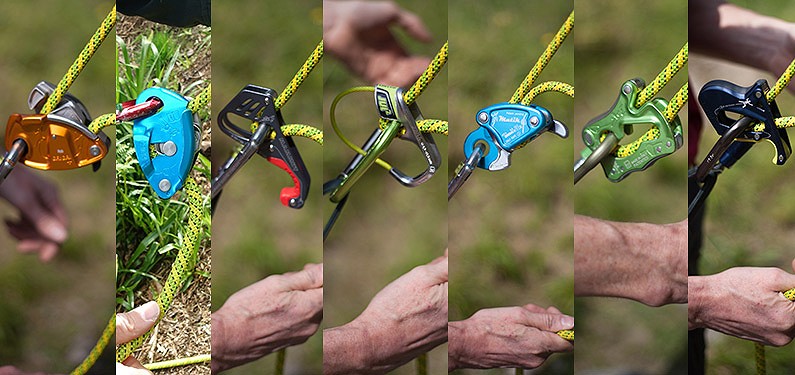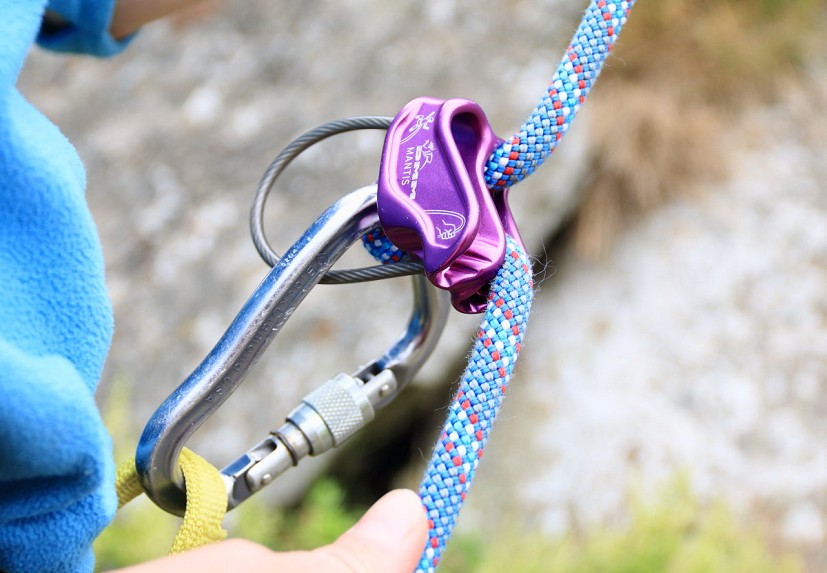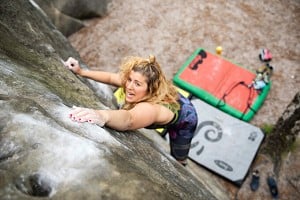
Paul Sagar explores why climbing accidents - specifically ground falls - are rarely discussed openly...
The bond between a climber and a belayer is sacred. After all, the climber is placing their life into the other person's hands. But what happens if that bond gets broken, and the climber is dropped in a serious fall?
This subject is in many ways taboo. Perhaps unsurprisingly so, given the potential seriousness of the consequences. Few would want to admit to ever having dropped a climber. Partly out of guilt, but also from fear of the scathing judgements sure to follow. In writing this article, I was specifically asked not to use real names by the people I interviewed – a strong indicator of the stigma that they felt. But this taboo is itself a source of danger. After all, climbers do get dropped, and if we aren't talking openly and honestly about how and why this happens, then the likelihood is that more, not fewer, people will sustain potentially devastating injuries. It's time to break the taboo.
***
A few months ago my friend Hannah dropped her climbing partner Roberto at an indoor wall (not their real names). I rated Hannah then, as I do now, as a very good belayer. I'd climbed with her on many occasions before the accident, and I've climbed with her since. But she made a mistake, and Roberto nearly paid a very heavy price.
After finding out about their accident, and whilst still waiting to hear how badly injured Roberto would turn out to be, I realised that this was the third ground fall I was directly aware of at an indoor gym in less than two years. The other two I witnessed myself: a climber being dropped from the top of The Lock Climbing Wall in Essex, and a 2/3 decking out in late 2018 at The Castle in London. (In both cases I was extremely impressed with the response team at each gym, who handled the situations superbly well.) But I thought to myself: three incidents in two years - that seems a lot.
To find out more I got in touch with the Association of British Climbing Walls (ABC), in order to get a sense of the wider picture. The ABC data is not a complete account of everything that happens in UK climbing walls, because not everything is reported to them. But they were able to tell me that of the 27 users who reported to their Accident Reporting Database, 918 accidents were recorded in 2019. Of these, 7 were ground-falls (3 from autobelays), and accidents occurred with climbers falling from the following heights:
Lead falls:
6 falls from 1-2m
7 falls from 2-3m
2 falls from 3-4m
1 fall from 6-9m
1 fall from 12-15m
From Auto belays:
2 falls from 3-4m
1 fall from 6-9m
Whilst top roping:
1 fall from <.5m
1 fall from .5-1m
1 fall from 2-3m
1 fall from 3-4m
As I say, this data is not complete, but even if only a snapshot it shows that accidents are happening. And if you think that 'only' 7 ground falls in a calendar year isn't that many, imagine how you'd feel if one of that number was your climbing partner, your husband or wife, or your child. It's a cliché, but it's still true: even just one person decking out in a commercial climbing wall is one too many.
Rich Emerson, chair of ABC, is keenly aware of the issues: 'We want to keep developing the quality, quantity and reporting of information from our database and we actually have a paper on our board meeting agenda in January to look at how we can take the database forward to include both accidents and near misses and to develop its overall structure.'
One suggestion might be to make all data public, year on year, on the ABC website, with an expectation that all climbing walls report incidents and near misses to the central database as a matter of course. This could potentially be linked up with the BMC's recently launched online accident reporting initiative, to give a clearer overall picture of what is happening both indoors and out. (Indeed, in addition to the incidents mentioned above taking place in gyms, I know at least two other climbers who have been dropped while climbing at outdoor crags in the past ten years, both of whom are lucky to still be walking. Ground falls happen, and my suspicion is that they happen much more than we like to admit. If so, that is a big problem.)
We all have an interest in knowing how many accidents may be happening, and in turn what the main contributing factors are, so that we can all work at reducing the number of serious incidents. Climbing, after all, is dangerous, even if one is likely to forget this as comfort and experience with the sport grow. The way that we can and should manage that danger is by reducing the potential for getting things wrong, in particular through encouraging best practice and fighting complacency. But if we don't even have a reliable picture of how many times things are going wrong, or if there is a common factor underlying most accidents and we're not aware of it, then we cannot improve.
Happily, ABC are indeed aiming to tackle the situation. Rich tells me that 'there is currently a group being facilitated by The BMC including ABC, Mountain Training and Technical Advisers looking at how we can make belaying safer both indoors and out. Outputs from this group are likely to include videos, posters and a social media campaign.' A centralised campaign may well be required, not least because individual commercial climbing gyms have understandable reasons for not wanting to trumpet the occurrence of accidents. But the danger at present is that we as climbers become complacent about the risks involved, assuming that serious falls are exceptionally rare, and only happen 'to other people'. Of course, without more complete data, it is difficult to know if my own personal experience is a statistical outlier, or if I've witnessed a lot of accidents because they just happen more regularly than we tend to think. And that's precisely part of the problem: we just don't know either way.
***
A core component of the taboo around belayer error is the presumption – common amongst experienced climbers – that only bad or very inexperienced belayers drop their partners. But this is just false. And the arrogant assumption that follows in turn – that you are too good and or/experienced to drop your partner – is putting climbers at risk.
Take the case of my friend Hannah. She was belaying – as she usually did – on a regular tube device. For a split second she loosened her hand on the dead rope to rearrange to a more comfortable position. At that precise moment - when her mind was elsewhere and she was belaying on autopilot - Roberto fell. As she puts it: 'It happened so fast, within 2 seconds he had gone from climbing up the wall to landing on the ground. I barely registered what was happening, only the friction burns on my hand attested to some instinctive grabbing of the rope. It would take me a while to understand what happened, but essentially my eyes had drifted to a climber on a neighbouring route. It was at that moment that Roberto slipped – and the fact I didn't see the beginning of his fall meant I couldn't react in time.'
A split second was all it took. If you think "that could never happen to me", or "I would never make such a mistake", well the truth is you're either deluded or a liar. Nobody can give 100% concentration, 100% of the time. And somewhat ironically, the more experienced you are, the more likely you are to get complacent, act on autopilot, letting your gaze and mind wander. I know for a fact that I have done exactly what Hannah did. The difference is simply that my climber didn't fall at the precise moment that I wasn't paying full attention. I got lucky. Hannah and Roberto didn't. The same is true for everyone else, one way or the other.
The consequences of Roberto's accident were serious. He fell 9 meters, landing on his back. Tests would later reveal that he fractured his C3 vertebrae – though in the immediate aftermath it was unclear whether the damage might be far more serious. Roberto spent the next month in a great deal of pain, and was not able to resume climbing for 3 more months. In the end it was actually lucky escape, given how much worse it could have been. This all happened because of a moment's lack of concentration, something that can and does befall every belayer in the world.
***
In the wake of such an accident, sympathy focuses on the dropped climber. After all, they are the one who most obviously suffers, both physically and mentally. As Roberto puts it, although he is now physically able to climb again, perhaps the biggest battle remains the mental one. 'It's been a continuous effort to keep myself going and trying to climb as I did before. I'm still not there after almost 6 months. But I'm slowly getting there.' Tying in on lead remains for him a semi-traumatic experience, and getting back to the point of being comfortable taking lead falls is still a long way off.
Yet it would be a serious mistake to think that Hannah walked away from the incident unscathed. In a situation like this it is easy to point fingers and vilify a belayer from a position of self-satisfied superiority, firm in the (false) conviction that you could never do such a thing. But as well as being simply wrong, this also completely overlooks the fact that dropping a climber is a deeply traumatic incident for the belayer. Here's how Hannah put it:
'Immediately after the accident people came rushing to help Roberto. I was in shock, still holding the rope, until someone kindly took it from me and my device. At that moment I couldn't bear to see him on the floor and burst into tears as I rushed around a corner, away from the horror I'd created. My mind was racing in so many different directions – what had just happened? How? Will he be ok? Will he walk again? How can I face him? Every time I managed to calm myself down a little, my brain replayed his heart-wrenching cry as he fell, and I felt sick over and over again.
I had never endangered anyone's life before this accident. Knowing I was to blame was a huge shock, and I barely thought of much else for the rest of the week. Certainly the few days immediately afterwards were spent mostly in or on my bed, as I tried desperately to come to terms with the magnitude of the situation. Word began to spread round our climbing club, and I began to receive messages of support. At this point I still didn't really feel like I deserved the support I was getting, but in time the rawness faded a little, and I could start to appreciate the kindness.'
Speaking to Hannah in the wake of the incident, I was struck by just how awful the experience was for her. After all, she had dropped her friend – and could have killed him. She felt crushed by the guilt. And then there was the fear that she would be ostracised by other climbers, labelled an unsafe belayer whose climbing days were done.
As it happened the opposite was mostly the case. 'Initially only the friends in my climbing club knew about the accident, and the vast majority were super supportive. We talked openly about what happened, which made it so much easier to deal with, even though it brought up difficult memories and feelings.' However, not all were so forgiving. 'One climber friend was much more shocked when learning about it, and was visibly struggling to know how to react. They later told me they agreed to climb with me that day because they didn't want to upset me further.'
This, however, leads us to one of the problems arising from the taboo around this subject. As Hannah puts it, someone only agreeing to climb with her so as to try and protect her feelings 'makes me more hurt than if they had immediately asked for a break from us climbing together, while I regain their trust.' After all, 'my feelings about continuing to climb should not have been placed above a friend's feelings of safety. I would never expect anyone to climb with me if they didn't want to."
The sense of awkwardness that Hannah's friend felt is entirely understandable. But it leads to a dilemma that is a sign of the unhealthiness in our current climbing culture. Either risk hurting a friend's feelings, or tie-in at the sharp end whilst not being at all comfortable with what is going on. Neither is a good place to be, and nobody should be finding himself or herself forced to choose between such options. To avoid this, frank and open acknowledgement of the fact that anybody can screw up and drop a climber is needed. In turn, nobody should look down their nose at those who have committed the "sin". Likewise, it should also be perfectly acceptable to simply turn down the offer of a catch from a particular partner, for whatever reason.
But we are currently a long way from that. Who can honestly say that they wouldn't be offended if someone refused to climb with them because they judged their belaying unsafe? What should be a frank and straightforward discussion about safety instead becomes one about pride, with one person feeling accused, and the other nervous about raising the subject at all. I can think of at least one person whom friends and I have "jokingly" tried to fob off on each other so as to avoid climbing with. When a different friend said to me – correctly – that we should have a proper chat with the belayer in question to try and sort things out, I laughed it off and avoided the subject. I felt too awkward bringing it up face to face. Another friend – who wished to remain anonymous – told me that she once dropped a partner when she was starting out climbing, but has rarely told anybody about this, because she is ashamed and worries that people will refuse to climb with her if they know. This is not a good place for any of us to be.
***
So what can we do? The ultimate aim needs to be to reduce the number of accidents, period. Reducing stigma is a means to that end, but obviously not the end in itself. Hence there are two main ways we can bring down the number of serious accidents: reducing intrinsic risk by making better hardware choices, and reducing complacency amongst climbers.
As regards the first, an obvious way in which Hannah and Roberto's accident could have been prevented would have been if she had been using some sort of assisted braking device. In using a regular tube device, as soon as the fall began, and given that she did not have her hand properly positioned on the dead rope, the situation could not be rescued. Assisted braking devices – like the Petzl GriGri, the Climbing Technology Click-up, or the Mammut Smart – can be literal lifesavers in this regard. Of course, no assisted braking device removes all risk (improper handling and unforeseen accidents can, and do, still occur). But such devices significantly reduce the risk of accidents if used properly, especially in climbing gyms, where further external risks such as rope-work complications at belays are removed. I can think of at least one time last year where if I hadn't been using a Click-up, a surprise fall from my heavier partner would definitely have resulted in him hitting the floor, precisely because my mind was elsewhere when he took the lob.

In the wake of the accident, Hannah has switched to always using a GriGri for indoor and sport climbing. (A lack of hassle-free assisted braking devices for two-rope trad belaying remains, to my mind, an obvious gap in the market.) Similarly, her club conducted an internal accident review, with all members notified of what happened and how, with a new policy adopted of recommending that all members consider using assisted braking devices when possible.
Interestingly, prior to the accident both Hannah and some other members of the club were largely dismissive of the use of assisted braking devices. Being predominantly trad climbers, and hence familiar with using tube devices mostly to belay on two ropes, and with none of them ever having dropped a climber before, there just didn't see much point in paying for an expensive device for indoor use alone. It took a serious accident to wake many of them up to the needlessness of the complacency that had taken hold.
Ironically, all of these climbers who were sceptical about assisted devices would have insisted on the importance of wearing a helmet when trad climbing. They were risk-sensitive out of habit in one area, but risk-insensitive out of habit in another. The point here is not to point or wag fingers. It is to notice that complacency, and set ways of thinking, sneak up on us all – and it is then that we are most likely to make preventable mistakes.
A core feature of human psychology is that habit makes us complacent, and in turn bad at judging risk (just think about how much less carefully you drive on the motorway the 500th time vs. the first). Hence, if you're reading this and thinking that you are somehow different, then you are living proof of the very point being made. When you feel like you are special, and that you don't need to bother, that's a very good sign that you are not special and that you more than anybody does need to bother. In thinking that you can't screw up, you've become the person most likely to screw up.
How to end such complacency? Due to the nature of psychological habituation tending to lower risk aversion, and the scientifically well-established tendency of individuals to over-estimate their own abilities when it comes to tasks that they think they are good at, it will be a never-ending battle. But a good start will be ending the taboo surrounding belayer error. After all, if it stops being taboo to openly discuss the ease with what belayer error can be committed by any of us, at any time, then complacency and arrogance can be reduced across the board. In turn, fewer accidents should hopefully occur.
***
It's been a difficult few months for both Roberto and Hannah. Roberto is climbing again, but pulling on remains a daunting and nerve-wracking experience, and he is a long way from capturing the easy joy of climbing that he once found so natural. Hannah has faced her own struggles, which should only be difficult to sympathise with if you are making the complacent mistake of thinking it's impossible that you might one day find yourself in her shoes.
Amazingly, Roberto was one of the people most willing to extend a healing hand in Hannah's direction. The very first time he got back on the wall, he asked her to be his belayer. 'I thought she would be the best person to do it with in order to give us both the confidence to move on from the accident.' This meant a lot to Hannah. 'It still makes me emotional that he made this decision, but it attests to his outstanding strength of character throughout the whole process. That he seemed to have no hard feelings towards me, and that he trusted me enough to belay him again – this was possibly the most humbling part for me. Then to see him out trad climbing a few months later really was such a joyous moment for everyone I think.'
If Roberto can extend such generosity of spirit, surely the rest of us can too. But as Hannah went on to say: 'I see lazy belaying at my local wall and I get frustrated, angry, and nervous. I wish climbing walls put more emphasis on training for lead climbing, in the same way they do for top-roping with beginners. The risks are huge, but yet can be dramatically reduced by knowledge and understanding of the choices we make.'
She's right. And it shouldn't have to take a serious accident for the rest of us to wake up to it.
- DESTINATION GUIDE: Stockholm Sport Climbing 21 Feb, 2023
- REVIEW: Peak Limestone Rockfax 30 Jun, 2020
- ARTICLE: Guidebooks: What They Say vs. What They Mean 10 Oct, 2019
- ARTICLE: Online Budget Gear - The Perils of the Bargain Buy 18 Jun, 2019
- DESTINATION GUIDE: Carinthia - Austria 11 Aug, 2018
- SKILLS: From Punter to Crusher: How to Climb Sport 7a 21 Jun, 2018
- ARTICLE: Cryptic Crags 18 Apr, 2018
- DESTINATION GUIDE: Tensleep Canyon: A Wilderness Paradise 15 Sep, 2017


















Comments
So most of those falls the belayer was effectively irrelevant, the climber needed a spotter instead (a recorded fall from the height of a chair is hardly a statistic of interest).
Assisted braking (note the correct spelling) are not a category of belay device for certification nor defined. ALL belay devices "assist" in braking the rope.
Unless the ABC have some better statistics it should be noted that the pseudo-locking devices ended up with a worse record for dropping climbers compared with manual assisted locking devices (Grigri and co) and traditional plate/tubes in the more extensive DAV statistics.
Paul, I really enjoyed the main content of the article, I think we are only just on the cusp of actually talking about mistakes, near misses and how to educate the "climbing population" of improvements and changes to accepted/recommended techniques and methods.
However, regarding the recommendation of using an assisted belay device, was there any data from the ABC showing that these falls at indoor walls were all from/mainly from people using traditional devices? Was there any data to show that assisted belay devices are "safer"? The reason I say this is because the DAV stats seemed to show they have a worse record, especially when it come to ground falls when lowering.
The current working title of EN 15151-3 is Braking devices with amplified braking.
I may have misread it, I was reading it quite quick, but it suggests there's no ABD that works with two ropes?
Smart Alpine and and the Alpine Up, perhaps there's other, I'm, not sure.
Nice article Paul. I like to imagine Sarah-Jane is sharpening her critic's pencil as I type ; )
It would be a shame if all the debate was on the type of belay device used (assisted, or otherwise). The other big takeaway is Belaying is a serious responsibility; so take it damn seriously. Work at being the best you can at it (and that might include thinking about the device you use), and always guard against complacency.